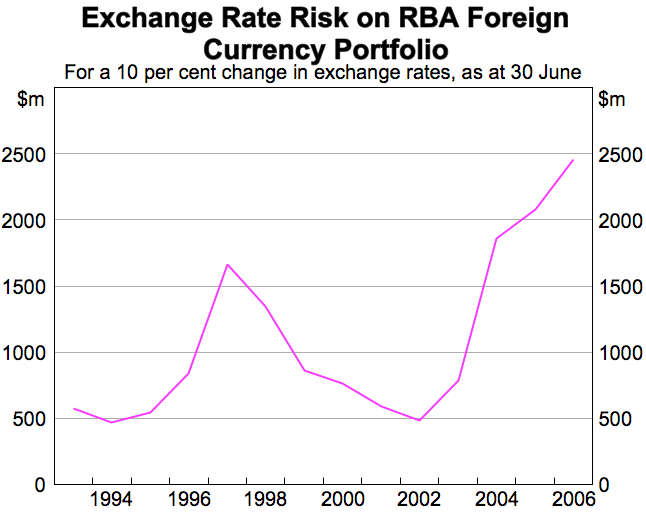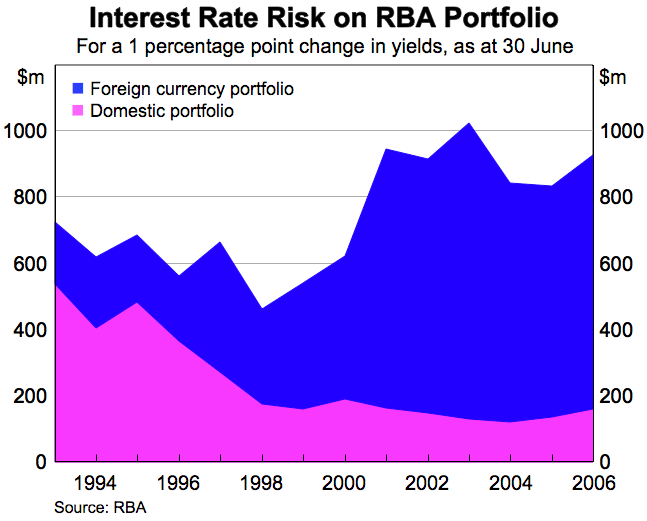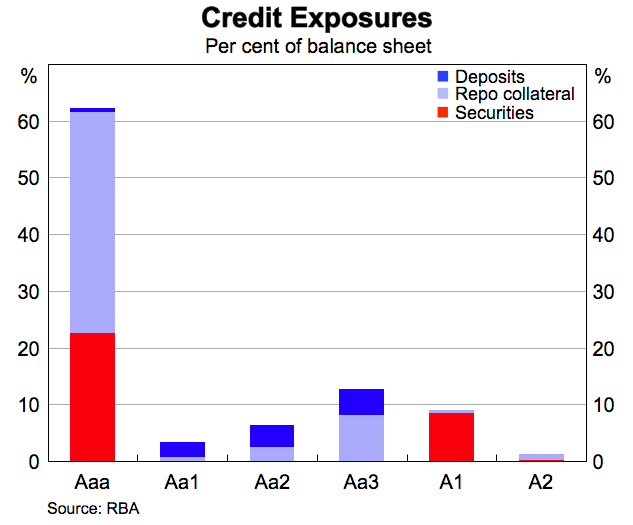Reserve Bank of Australia Annual Report – 2006 Risk Management
Objectives and Governance Structure
The Reserve Bank is exposed to a range of risks in fulfilling its responsibilities. In financial terms, the largest risk stems from operations in the financial markets and the holding of assets needed to support those operations. Operational risks are also significant, given the large volume of banking services provided to clients and the sensitive nature of much of the material with which the Reserve Bank deals.
Responsibility for managing those risks rests with line management. This takes place within a framework overseen by the Risk Management Committee, comprising the Deputy Governor as Chairman; the Assistant Governors of Financial Markets, Business Services and Corporate Services; the Heads of Audit and Risk Management; and the Reserve Bank's General Counsel and Deputy Secretary. The primary responsibility of the Committee is to ensure that the full spectrum of non-policy risks is effectively managed across the organisation, particularly those which span more than one department. The Committee meets at least quarterly and keeps the Audit Committee informed of its activities; it reports annually to the Reserve Bank Board.
A small Risk Management Unit assists the Risk Management Committee in its work. Its main tasks are to advise departments and co-ordinate the risk management process across the organisation. The Unit maintains a close working relationship with, but remains separate from, the Audit Department.
The sections below describe the various risks, and the associated management practices, in more detail.
Balance Sheet Risks
The main risks are exchange rate risk, interest rate risk and credit risk. These risks are managed by the Financial Markets Group, within parameters and controls set by the Governor and the Reserve Bank Board. The main features of the control framework include limits on open positions and counterparty exposures, a well-defined benchmark for the foreign reserves portfolio, a clearly defined delegation structure and detailed procedures manuals. Compliance with the control framework is reported daily to senior management, including to the Assistant Governor, Financial Markets and Head of the Risk Management Unit.
Exchange Rate Risk
The foreign currency assets the Reserve Bank holds outright are exposed to exchange rate risk, as their value (when measured in Australian dollars) varies with movements in the exchange rate between the currencies in which the assets are denominated and the Australian dollar.[2]
The level of foreign currency exposure is largely determined by intervention operations, which are decided on policy grounds, and cannot be separately managed. The exchange rate risk from holding a given level of foreign currency is, however, reduced by the diversification of foreign currency reserves across three currencies. Forty-five per cent of foreign currency reserves are held in US dollars, 45 per cent are held in euros and 10 per cent in Japanese yen.
In addition, intervention operations, when conducted successfully, work to reduce risk. This is because they result in the Reserve Bank selling foreign exchange when the Australian dollar is low, resulting in its holding less foreign currency when the Australian dollar is more likely to appreciate. Conversely when the Australian dollar is high, and is more likely to depreciate, the Reserve Bank will tend to hold more foreign currency.

As discussed in the chapter on ‘Operations in Financial Markets’, the Reserve Bank has replenished reserve assets over recent years. This has added to the level of exchange rate risk on the Reserve Bank's balance sheet. On current holdings, a 10 per cent rise in the Australian dollar (on a weighted average basis against the three currencies in the portfolio) would result in valuation losses of around $2.5 billion.
Interest Rate Risk
The Reserve Bank's balance sheet is exposed to considerable interest rate risk because most of its assets are financial assets, such as domestic and foreign securities, which have a fixed income stream. Their value is therefore subject to movements in domestic and foreign market yields. Specifically, because of the fixed income stream, the value of these securities falls when market yields rise. Securities that have a longer maturity (or duration) contain a greater degree of interest rate risk, as the income stream is fixed for longer periods.

Over the past year, growth in the balance sheet has resulted in an increase in interest rate risk, although this was offset to some extent by a reduction in the average maturity of assets held. The maturity of assets was reduced in order to retain the flexibility to be able to meet the withdrawal of deposits by the Future Fund. Across the balance sheet, including domestic and foreign assets, the Reserve Bank would suffer a capital loss of about $930 million if interest rates in Australia and abroad were to rise by 1 percentage point across the yield curve.
Credit Risk
Credit risk is the potential for financial loss arising from the default of a debtor or issuer. In contrast to exchange rate and interest rate risk, which the Reserve Bank is generally unable to avoid because of policy imperatives, credit risk is held to relatively low levels. This is because the Reserve Bank holds only highly rated securities. In the case of the domestic portfolio, only securities issued by either the Australian Government or the State and Territory borrowing authorities are held outright. The majority of these securities are rated Aaa. The foreign currency portfolio is invested primarily in securities issued by the US, German, French and Japanese governments. Some foreign reserves are also held as investments with the BIS, mostly in the form of direct claims on which there is very little risk of default. While funds invested in the Asian Bond Funds have an exposure to securities of lower credit rating than those otherwise held as foreign reserves, the amount invested is relatively small and the average credit rating is still well within the range of investment grade paper.

Some foreign assets are also held as deposits with commercial banks, and are therefore subject to the risk of default by these banks. There is also a default risk associated with carrying out transactions with market counterparties, since they may not be able to complete transactions entered into. Various steps are taken to minimise such risks: dealings are confined to highly creditworthy counterparties; foreign currency commercial bank deposits are placed only with banks that have a high credit rating (a short-term rating of P-1 and a long-term rating of Aa3 or above); and foreign exchange transactions are conducted only with counterparties rated P-1 (short term) and at least A3 (long term).
Credit risk arising from repurchase agreements and gold loans is much lower than for deposits, since these transactions are collateralised with either securities or cash. For this reason, the required credit standing for counterparties in these transactions is lower than for deposits and foreign exchange. Foreign repurchase agreements and gold lending transactions are conducted with counterparties rated P-2 and Baa1, or better. Other measures to control risks include requiring that the initial position be over-collateralised, that the collateral be revalued daily and that counterparties supply additional securities if the value of the securities falls below a required amount.
In the domestic portfolio, no minimum credit rating is explicitly assigned to counterparties as the operations are conducted for policy purposes. However, because dealing is restricted to RITS members, which are primarily banks operating in Australia, the credit rating of domestic counterparties tends to be quite high.
For the foreign portfolio, in addition to assigning minimum credit ratings criteria, a limit on the absolute exposure to each counterparty is imposed in accordance with the institution's financial strength, credit rating and the size of its capital base. As the Reserve Bank may deal with a counterparty across a variety of financial products, the exposure to a given counterparty is measured so as to capture all transactions with that party. Counterparty limits are reviewed on a regular basis and adjusted immediately following changes to credit ratings.
Settlement risk (i.e. the risk that the counterparty may not be able to complete the deal) is mitigated in a number of ways. For outright and repurchase agreement transactions in domestic and foreign securities, settlement risk is eliminated by use of systems that are based on delivery-versus-payment – i.e. the simultaneous exchange of securities and cash. Settlement risk can be significant for foreign exchange transactions because the two currencies of the foreign exchange transaction are settled in different time zones, which may require the Reserve Bank to pay out funds well before it receives any funds in return. Because of this, in addition to restricting foreign exchange transactions to highly rated counterparties, a limit is imposed on the total value of foreign currency transactions settling with a counterparty on a given day.
Operational Risk
While all parts of the Reserve Bank are exposed to operational risks of varying degrees, the most significant are those associated with carrying out the market operations and supplying banking and settlement services to customers and to the market as a whole. Significant operational risks can also arise from the mishandling of sensitive information, which can cause financial loss and/or damage to the organisation's reputation.
Operational risk in financial market activities arises from the large volume of transactions undertaken in markets each day. Around 72,000 transactions were undertaken in 2005/06, with average daily settlement flows of around $22 billion. These risks are managed by having systems and processes that are efficient and robust. To strengthen the control over operational risk, a new financial market trading and settlement system has been installed. Foreign operations were moved onto this platform during the 2004/05 financial year and domestic operations were moved onto it early in 2006. As a result, dealing functionality and risk controls for both the foreign and domestic operations are now on one integrated platform.
One of the most significant risks facing any financial institution is financial loss or reputational damage from unauthorised transactions by staff. A number of controls and processes are in place to minimise this risk. These include a clear decision-making hierarchy, with all staff involved in financial dealing having limits to their authority to take risk; controls in the computer systems to prevent unauthorised dealing; separation between staff who initiate transactions and those who settle them; an independent middle office to monitor compliance; and a strong internal audit function.
Some operations involve providing services to clients or market participants. For example, the Reserve Bank is the main banker for a number of government agencies, and processes on average about 280 million transactions a year, including all Australian Taxation Office, Medicare Australia and Centrelink payments. It also provides real-time interbank payment and settlement services through RITS, which typically involve processing about 25,000 payment instructions per day, for an average daily value of $145 billion. It is crucial that these operational risks be managed to ensure that the functions are carried out in an efficient manner and with complete reliability.
A major program to strengthen the Reserve Bank's back-up arrangements was advanced further during the year. Construction work on a new self-contained business resumption site in north-west Sydney commenced and it is expected that the new facility will be ready for use in 2007; more details are provided in the chapter on ‘Management of the Reserve Bank’.
The Reserve Bank, in common with most other organisations, has also considered the key issues that might arise if an avian flu pandemic were to occur in Australia. Such an event raises quite different business-continuity issues since it would be staff – rather than facilities and/or systems – that become unavailable in an influenza pandemic. A key part of the strategy for dealing with an avian flu pandemic would be to have staff work from home to the maximum extent possible. Various measures were taken during the year to enhance this capacity.
Footnote
This is not the case for foreign exchange held under swaps as the exchange rate at which the foreign exchange will be delivered is agreed at the start of the swap. [2]